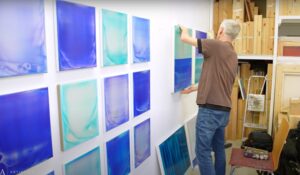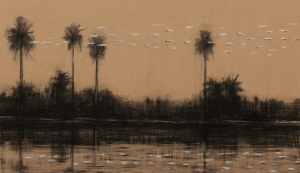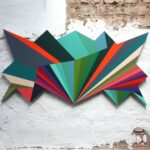The Kunststation cultural centre in Kleinsassen, Germany is putting on an exhibition dedicated to Japanese artist Hachiro Kanno through to the end of August 2015. One weaves through a large selection of paintings and installations which conveys a work inciting a “contemplative immersion into another world.” Below you will find a text written by Elizabeth Heil, Art Director of the Kunststation, which outlines the artist’s approach, putting it in the cultural context in which it is anchored.

Thoughts on the Work of Hachiro Kanno
By Dr Elisabeth Heil, Art Director of Kunststation Kleinsassen (Translated from German by Bryin Abraham)
In all truth, one shouldn’t write or say anything about art of such supremacy that it reveals itself when contemplated in silence and which, via this silent consideration, opens a door to a new perceptional consciousness.
Ultimately, one would not write or say anything were it common in Europe, when looking at art, to give the virtue of silence preference to loquacious eloquence. But when we are confronted by art, we are used to accepting it as a complex construct and to analyzing it, to determining its advantages and disadvantages, and to evaluating it from different perspectives. And not only contemporary art often raises the disquieting question regarding what the artist wants to say to us.
The contemplative immersion into another world
Hachiro Kanno‘s work, however, already distances itself from such questions at first glance. This confuses — and then again, does not. For any attempt at analyzation proves itself as dilettantish banter and only weakens the essential: the contemplative immersion into another world.
The experience that Hachiro Kanno presents to us is one of a balanced view of the world and art in one. Born in Japan in 1944, as the son of a Shinto priest and renowned calligrapher he literally experienced, learned, and absorbed the traditional Japanese arts of calligraphy and painting from childhood onwards. Later, he studied western-style art in Tokyo and Paris. Since 1968, Hachiro Kanno has lived and worked primarily in Paris and Saint-Rémy and occasionally in Japan, but it was in France that he came to fully appreciate the traditions of Japan.
Shintoism, as a religion, venerates nature and life in all forms and also sees beauty in simplicity and clarity. Influenced by Zen Buddhism, Shinto arts play with perception and touch upon a reality that cannot be appreciated through the five human senses alone. The pictures and poems (haiku) aspire to stimulate the intellect into seeing and experiencing much more than just the specifics of the presented images and words.


Hachiro Kanno is a master of the ink brush, quickly and assuredly capturing in the deepest black to the most delicate glazes everything that touches him during everyday life and while traveling the world. He records it all in sketchbooks, often accompanied by a self-written haiku. The “recordings” often evoke more within the viewer than the ink actually shows. For example, when Hachiro Kanno paints a small fleet of boats on the top of the sketchbook page — and nothing more. What we see in the lower “empty” area is the sea, absolute calm and without waves, luminous but not dazzling. We inhale a warm, slightly salty air, delight in the harmony of a quiet day .
The mood of the moment and the essence of the landscape
Hachiro Kanno also opened his sketchbook during a sojourn in Kleinsassen in 2014, recording within it the village church and impressions from around the Milseburg. He captured the mood of the moment and, at the same time, the essence of the landscape: the rockiness, the gliding recession of the crests, the sparse vegetation, the misty valleys, the contemplative absorption of the view into the wide distance. And it is all done with the ink brush, which portrays not in excessive detail but rather through abbreviation, all the while revealing far more than any photo-realistic depiction.
This reduced formal language, which is appertain to traditional Japanese painting, reveals itself as almost non-objective in nature. At the same time, it is nevertheless beholden to the essentials. When everything concrete tends towards the imaginary, when the view is directed through and beyond the forms, the world of things can also disperse while simultaneously evoking images of the things. In doing so, the contradictory doesn’t contradict itself but, instead, flows into one another, creating a harmonic entirety. As per the best-known sutra of Buddhism, the Heart Sutra: “Form is emptiness, emptiness is form.” Hachiro Kanno himself says, “Plein est vide et vide est plein” — full is empty and empty is full — and has named a whole series of works as such. Light and darkness (shadow) and their reversal are thematized. Painting, sculpture, and the art of calligraphy merge on paper and canvas, in objects and installations.

Time and again Hachiro Kanno returns to the basic forms of the circle, triangle, and square, which represent water, fire, and soil — the circle, albeit, also represents eternity and perfection. And for the enduring, the eternal, and the ephemeral, the flowing, Hachiro Kanno seeks and finds other forms as well: the stones, straw bales, and ponds in his installations. When the straw in Kanno’s land art installation has burnt away, the stone that previously lay atop of the straw remains as the enduring, the eternal.
Permanescence
The experience, perception, and awareness of nature and life, of becoming and passing, of movement and perpetuity — these are the concerns of Hachiro Kanno as a person and an artist. And this is embodied in his newly created word, “permanescence”: everything is in fluxion, yet the essence remains constant. The eponymous work series returns time and again anew to this fundamental question of existence. The chadō, the “way of tea”, precedes all instances of artistic production as an act of purification and concentration. For the black ink, Hachiro Kanno grinds the inkstone himself, determining with either a bit more or less water the consistency: from deepest hardy black to the subtlest translucent gray. The red, blue, and white are acrylic paints, which dry quickly and don’t mix with the ink, thus enabling a translucent superimposition of the ink and color layers — just like how patterns, actions, and thoughts can overlap in nature and life. From a standing position, Hachiro Kanno uses his entire body to conduct the movement of the brush across the paper and/or canvas. As in the art of calligraphy, the action is executed in one flow; there is no subsequent correctional overpainting. Each brushstroke and every drop is an expression of “permanescence”, just like existence and eternity can also not be subsequently changed. On occasion Hachiro Kanno adds a sutra to his paintings, written within a circular form or, more rarely, a rectangular plaque. “Sutra” means “thread”. And threadlike the sutra is worked into the painting. The text can only be seen and read under specific light conditions, because Hachiro Kanno utilizes a self-mixed writing liquid created from crushed mother-of-pearl for the inscriptions.
The fewest of Europeans are able to read and understand the columns of Japanese texts. The material and spiritual preciousness of the writing, however, is tangible to all. What one thinks and feels above and beyond the simple observation of the painting, whether one thinks of bird feathers, of waves, of sand patterns or wood grains, and where these memories lead to…?
Meditations on the essence of life in a comprehensive sense
Hachiro Kanno’s paintings are meditations on the essence of life in a comprehensive sense. The famous Japanese artist Hokusai once expressed the desire to live until the age of 110 because he hoped that by then he would have achieved the level of art in which each dot and every line would mean life itself. Hachiro Kanno is already close to perfection.
In all truth, one shouldn’t write or say anything about art of such supremacy that it reveals itself when contemplated in silence and which, via this silent consideration, opens a door to a new perceptional consciousness — to “permanescence”.





Video of the performance by Hachiro Kanno at Kunststation Kleinsassen, June 2015. Credit : Sandrine Cornillot





